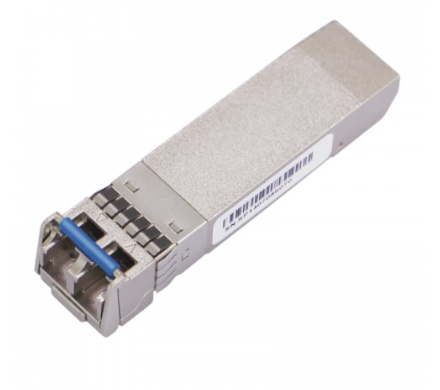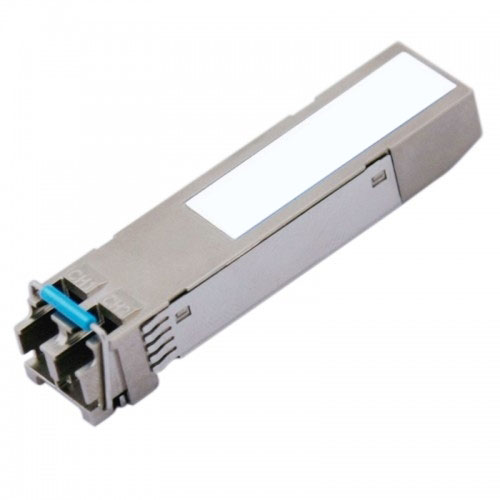- Related articles
- Optical Transceivers for Cisco WS-C2960S-48FPS-L Switch
- Optical Transceivers for Cisco WS-C3650-24PD-S Switch
- Optical Transceivers for Cisco WS-C2960C-8PC-L Switch
- Applicable to 100BASE-LX10 Standard Optical Transceiver Models
- 1 GBE SFP SX (1000BASE SX) fiber transceiver
- The Things You Need to Know about 40GBASE-CR4 Ethernet Standards
- Optical Transceivers for Cisco WS-C2960XR-48FPS-I Switch
- All Cisco DWDM-XFP-39.77's information (List price, Specs, Datasheet PDF, Compatibility ma
- All Cisco DWDM-X2-60.61's information (List price, Specs, Datasheet PDF, Compatibility mat
- Optical Transceivers for Cisco N3K-C3172TQ-10GT= Switch

Definition:
The enhanced small form-factor pluggable (SFP+) is an enhanced version of the SFP that supports data rates up to 16 Gbit/s. The SFP+ specification was first published on May 9, 2006, and version 4.1 published on July 6, 2009. SFP+ supports 8 Gbit/s Fibre Channel, 10 Gigabit Ethernet and Optical Transport Network standard OTU2. It is a popular industry format supported by many network component vendors. 10 Gbit/s SFP+ modules are exactly the same dimensions as regular SFPs, allowing the equipment manufacturer to re-use existing physical designs for 24 and 48-port switches and modular linecards.
Compact small form-factor pluggable CSFP transceiver supports network systems, especially those deploying single-fiber bidirectional transceivers in high density applications. The CSFP MSA defines a transceiver mechanical form-factor with latching mechanism and a host board, SFP-like, electrical edge connector and cage. The dual-channel CSFP has the same mechanical dimensions as the industry-standard SFP transceiver and is compatible with the standard SFP cage. The single-channel CSFP is half the size of the industry-standard SFP and SFF packages.
Difference between SFP+ and CSFP
SFP+ 10G
- 8GFC and 10Gbit/s 8.5G data rate
- SFP+ MSA Compliant
- Very low power consumption (<1W)
- With digital diagnostic monitor interface
- Operating temperature range 0 to 70 degrees Celsius
- 10G serial Electrical I/F
CSFP
- Support up to 1.25Gbps Data Links
- Single 3.3V Power supply and TTL Logic Interface
- 2XBi-directional transceivers in 1 Compact SFP transceiver package
- Class 1 FDA and IEC60825-1 Laser Safety Compliant
- Operating Case Temperature Standard: 0~+70C and Industrial -40~+85C
- Compliant with CSFP MSA Option 2 or Option 1
- Compliant with Digital Diagnostic Monitor Interface SFF-8472
Difference between SFP and XFP:
SFP transceivers are expected to perform at data speeds of up to five gigabits per second (5 Gbps), and possibly higher. Because SFP modules can be easily interchanged, electro-optical or fiber optic networks can be upgraded and maintained more conveniently than has been the case with traditional soldered-in modules. Rather than replacing an entire circuit board containing several soldered-in modules, a single module can be removed and replaced for repair or upgrading. This can result in a substantial cost savings, both in maintenance and in upgrading efforts.
XFP modules are hot-swappable and protocol-independent. They typically operate at near-infrared wavelengths (colors) of 850 nm, 1310 nm or 1550 nm. Principal applications include 10 Gigabit Ethernet, 10 Gbit/s Fibre Channel, synchronous optical networking (SONET) at OC-192 rates, synchronous optical networking STM-64, 10 Gbit/s Optical Transport Network (OTN) OTU-2, and parallel optics links. They can operate over a single wavelength or use dense wavelength-division multiplexing techniques. They include digital diagnostics that provide management that were added to the SFF-8472 standard. XFP modules use an LC fiber connector type to achieve higher density.
Conclusion:
SFP+ has a more compact form factor package than X2 and XFP. It can connect with the same type of XFP, X2 and XENPAK directly. The cost of SFP+ is lower than XFP, X2 and XENPAK. SFP+ modules can be described as 'limiting' or 'linear' types; this describes the functionality of the inbuilt electronics. Limiting SFP+ modules include a signal amplifier to re-shape the (degraded) received signal whereas linear ones do not. Linear modules are mainly used with the low bandwidth standards such as 10GBASE-LRM; otherwise, limiting modules are preferred. SFP+ also introduces Direct Attach for connecting two SFP+ ports without dedicated transceivers.
The CSFP design is modular to enable configurations of integrated 2ch modules. The CSFP transceiver consists of 2-channel Bi-directional transceiver unit with five sections: the LD driver, the limiting amplifier, the digital diagnostic monitor, the 1310nm DFB laser and the 1490nm PIN photo-detector. The optical output can be disabled by a TTL logic high-level input of Tx Disable, and the system also can disable the module via I2C.
What is CSFP?
1. What is CSFP ?
CSFP is the short of Compact Small Form Factor Pluggable,
It is based on the popular SFP package, and have the more advanced and compact CSFP package.
Byusing a dual-channel, four-channel design, the CSFP uses the existing SFP general-purpose interface,
But the external dimensions are reduced to half and one-quarter of the existing industry standards.

2. What is the working principle?
The CSFP optical moduleintegrates two BIDI SFP moduleson the outer dimensions of the traditional SFP module.
The module is consists of two PLC BOSAs to realize the two-way transceiving of the two channels under the same external size.
The pin definition and monitoring quantity are quite different from the traditional SFP module.
The other functions are basically the same.
LOS is the alarm signal, IC is the integrated chip, MCU is the microcontroller, and EEPROM is the power. Erase read-only memory, BOSA optical transceiver components.
CSFP completed the integration of two traditional single-fiber bi-directional SFP modules.
Its structure includes two independent optical transmit receive channels.
Each channel consists of a PLC BOSA device to complete the optical signal reception and electrical signal transmission.
And they are the core components of the CSFP module.

3.What are the types of the CSFP ?
Now in the market, the CSFP have 155M / 1.25G / 2.5G rate.
The common wavelength is 1490/1310nm to 10/20km, but up to 120km.
For the CSFP, it will have a large market necessary in the future.
We have all mostly seen our SFP connectorswith two separated ports. Whereas one is TX(laser) port which is used to transmit the signal, and the other one is RX(photodetector) port which is used to receive signals. This is the conventional two-fiber Bi-Directional communication. Undoubtfully we can say that these are the most used and successful formula which is still existing. When the time goes by there have been many requirements of adding more value to existing products and technologies in fiber optics. One of the questions was pretty simple, instead of using two fiber optic cables to send and receive, why can’t we use single optic cables to perform the activity? With the development of WDM technology, transmitting and receiving optical signals on separate wavelengths can be achieved through only one single fiber. If that is the case we need only a single port in SFPs which can also perform send/receive. This was lead to the invention of BiDi SFP transceivers. BiDi SFP transceiver is a compact optical transceiver module that uses WDM (wavelength division multiplexing) technology and is compliant with the SFP multi-source agreement (MSA).

For bi-directional transmission technology, “bi-directional” is meant in sense of using optical fiber in two directions, similar to the use of single railway track in two directions. BiDi technology allows transceivers to both transmit and receive data to/from interconnected equipment through a single optical fiber, thus saving optical fiber resources and doubling your network capacity.

BiDi SFP Modules in a switch
Unlike traditional optical transceivers, BiDi optical transceivers are fitted with wavelength division multiplexing (WDM) diplexers, which combine and separate data transmitted over a single fiber based on the wavelengths of the light. For this reason, BiDi transceivers are also referred to as WDM transceivers.
Working Principle of BiDi SFP
The difference between BiDi transceivers and the two-fiber optical transceiver mainly lies in that BiDi transceivers are fitted with WDM couplers, also known as diplexers, which help to combine and separate data transmitted over a single fiber based on the wavelengths of the light. BiDi transceivers are usually deployed in matched pairs to get the work most efficiently. And the diplexers of BiDi transceivers are tuned to match the expected wavelength of the transmitter and receiver that they will be transmitting data from or to.
There is two mechanisms that happen in the case of BiDi transceivers. Firstly, each signal which is sent/receive is operated in two different wavelengths. Secondly, bidirectional transceivers separate the two wavelengths into transmit and receive path with the help of wavelength division multiplexing (WDM) diplexers. Look at the below picture to understand these two core concepts.

Working Principle of BiDi SFP- Data Transmission principle
As you can see from the above diagram, the paired BiDi transceivers are being used to connect two devices. Device A is used to get upstream data, and Device B is used to get downstream data. Txmeans to transmit and Rxmeans to receive. The diplexer in one transceiver (Device A) should have a transmitting wavelength of 1310 nm and have a receiving wavelength of 1550 nm. The diplexer in the other transceiver (Device B) should have a transmitting wavelength of 1550 nm and have a receiving wavelength of 1310 nm.
Advantages of BiDi SFP
This single fiber BiDi transmission gradually becomes a popular and cost-effective solution for today’s data center and IT infrastructure because of its unbeatable advantages such as,
(1)BiDi SFP modules integrate duplex data link over a single optical fiber.
(2)By utilizing BiDi SFP transceivers, the fiber cabling infrastructure costs could be reduced. With the reduction of fiber strands by half, the number of patch cords and patch panel ports can be reduced accordingly, as well as reducing the amount of tray space dedicated to fiber management
(3)Working with BiDi SFP optical modules, the capacity and reliability can be increased by simultaneously operating at more than one wavelength to transmit and receive on a single strand.
(4)BiDi SFP optical modules support a transmission distance up to 120km.







































































